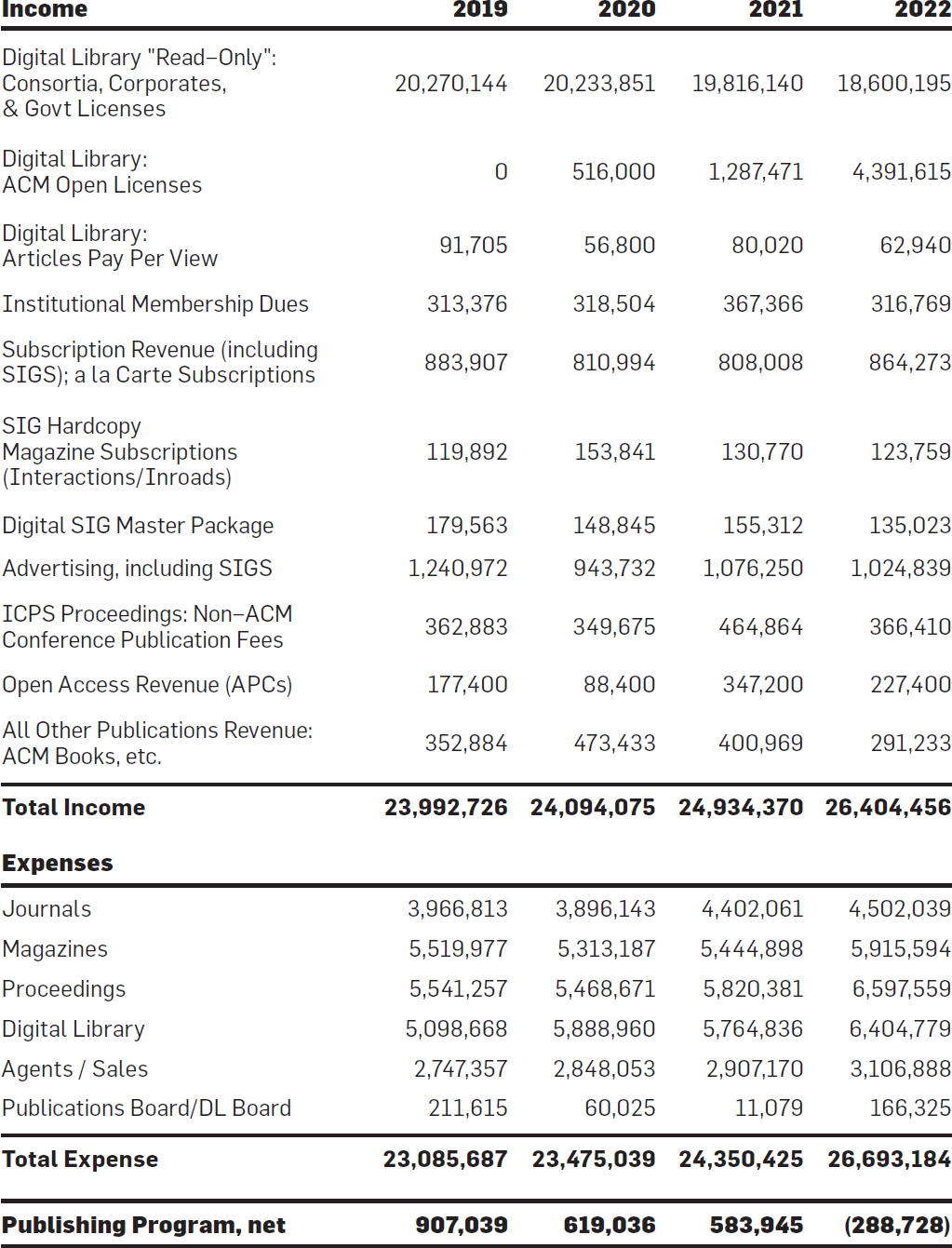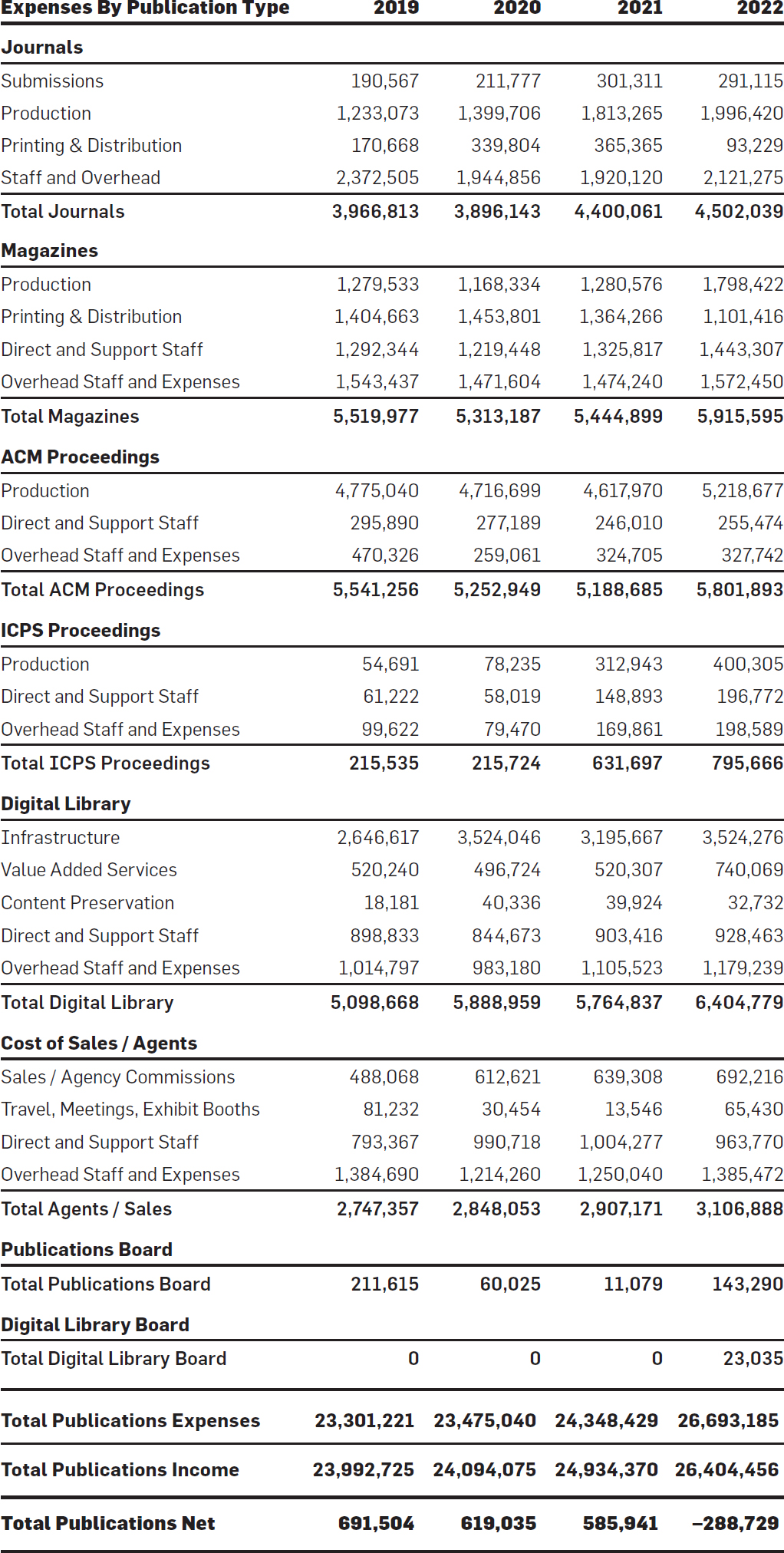In September 2023, ACM publicly reiterated its commitment to transitioning ACM’s Journal, Magazine, and Conference Publications programs to a fully Open Access model by the end of 2025, and as a next step along this journey, recently issued a press release announcing that ACM would transition its International Conference Proceedings Series (ICPS) to a fully Open Access model beginning Jan. 1, 2024. While many in the computing community may not be familiar with ACM ICPS, which is a mechanism for publishing high-quality non-ACM sponsored conferences, symposia, and workshop proceedings in the ACM Digital Library, there is great significance to this announcement, since in 2022 ICPS published approximately 9,500 peer-reviewed articles in the ACM Digital Library, which represents approximately 35% of all peer-reviewed articles published by ACM in that year. Assuming a similar number of published articles in 2024 as we experienced in 2022 and 2023, including the ICPS conferences, by the end of 2024 ACM will have transitioned nearly 60% of the articles it publishes annually to Open Access publication through a combination of ACM Open institutional licenses, author-paid Article Processing Charges (APCs), and financial waivers for peer-reviewed articles originating from the Global South. In addition, ACM has already unlocked all articles published from 1951–2000 and will soon transition ACM’s flagship publication, Communications of the ACM, to a Gold Open Access publication that will ultimately be subject to the same OA funding models as the rest of the ACM Publications program—that is, ACM Open, APCs, or financial waivers.
The underlying message here is that ACM is responding to the computing community’s directive to transition to a fully Open Access model and aiming to do so in a financially sustainable way, which brings us to the topic of ACM Publications Finances.
Over the past three (3) years, ACM has published detailed information about its Publications Finances from 2019-2021, and in this article, we are now publishing data for the calendar year 2022 (see Table 1). To our knowledge, ACM is the only Society or commercial publisher in the world to provide this level of financial transparency about its Publications Finances and remains committed to doing so in the future. We are doing this for the following reasons:
First, when developing the ACM Open “Read + Publish” model in 2019, we did so in close collaboration with a group of leading universities—including the University of California, Massachusetts Institute of Technology, Carnegie Mellon, Iowa State University, and the University of Minnesota—and consulted dozens of other universities around the world with whom we have close relationships. Building the model required doing a deep dive into our financial and publication data and sharing that data openly with our collaborators. As the model developed, it became clear that being totally trans- parent about the data with our entire institutional customer base, authors, volunteers, and other stakeholders would be the most effective way to tell the story of the model itself.
Second, as we continue to transition to a fully Open Access model (or combination of multiple OA models to be more precise), our customers are starting to experience a significant evolution in the overall value proposition from ACM. In the past, more than 90% of ACM’s Digital Library income that is needed to sustain the publishing program came from approximately 2,700+ universities and 100+ companies from more than 150 countries. With so many institutions subscribing to the ACM Digital Library, the average cost for each institution was very low compared to what other societies and publishers have historically charged for access to a publishing program the size of ACM’s. This large customer base made it possible for ACM to keep prices very low and evenly distributed around the world, and it also enabled ACM to offer large economic discounts to address issues of equity and access in the Global South (which ACM is committed to continue in the future). However, as the data showed us, the vast majority of ACM’s customer base is predominantly made up of consumers (that is, readers) of ACM-published articles, with only the top one-third (⅓) of those institutions actively publishing articles with ACM year after year. As more and more of the articles in the ACM Digital Library are published in front of the paywall, the risk of cancellations from the long tail of non-publishing institutions grows. Using this data, we were able to engineer the ACM Open pricing model to fairly balance pricing with the value institutional customers were receiving from ACM. For the bottom two-thirds (⅔) of these institutions, the transition to Open Access will result in lower pricing than was required prior to the transition, and most of the value these institutions will realize from their annual ACM Open licenses will come from value-added services inside the ACM Digital Library platform as opposed to a value proposition coming primarily from downloading PDF articles, which will ultimately be published without any access paywalls.
Third, the commitment to transition to being a fully OA Publisher by a specified date (Dec. 31, 2025) creates increased financial risk that needs to be understood by ACM and the computing community driving ACM toward its Open Access future. Most publishers are transitioning to Open Access “organically,” meaning they are letting authors decide whether to opt in for Open Access, and it may be that many of these publishers never achieve 100% Open Access. But taking this approach is far less risky, since authors at non-ACM Open institutions, who may not want to pay an APC, always have the option of submitting their articles elsewhere, which creates an inherent and somewhat unpredictable risk for our publishing program, assuming somewhere between 20% and 30% of our authors will be required to pay an APC when ACM flips to mandatory Open Access. ACM has generally taken the same approach since first launching hybrid or “optional” OA in 2013, but all that changed in 2020 when the ACM Council voted on a resolution to transition within a five-year timeframe.
This was a bold move that set ACM apart from nearly all other societies and publishers, and while we believe this is the right thing to do in the long run and will ultimately create significant benefits for our authors and the computing community in terms of increasing visibility, usage, and impact of ACM published articles, it also comes with financial and editorial risks that need to be understood, assessed, and acted upon to ensure the long-term health and sustainability of ACM’s publishing program and ACM as an organization. It is our view that publishing these regular financial reports is essential to keeping the community informed of our progress and the financial impact the transition is having on the ACM organization. As you will see from the 2019-2022 calendar year financials provided in this article, ACM Publications is not a “highly profitable” enterprise, unlike many of the societies and commercial publishers we compete with for high-quality computer-science research papers. But this is largely by design. In a for-profit publisher, this would be viewed as a significant problem and not something to highlight to the “market,” but for a non-profit member organization such as ACM, we own this fact as a badge of honor and work hard to ensure that we balance the community’s need for high-quality publications delivered through an industry-leading technology platform while at the same time doing this in a cost-effective way.

Table 1. 2019–2022 High-level ACM Publications Financials.
In 2022 the ACM Publications program generated a small loss of 1% on income that grew 5.5% from the previous year primarily due to inflation, significant investments in new publications and the ACM Digital Library platform, and lowering prices for some of ACM’s smallest university customers (Tier 10s) as we transition to the OA model. This loss is a decline from previous years, where the program has historically generated a small surplus of approximately 3%-5%. The ACM Publications program could be more profitable if ACM were to charge institutional customers more for subscriptions to the ACM Digital Library and invest less in the Digital Library platform or ACM’s production services, but providing a high-value, low-cost service has been central to ACM’s value proposition for more than 75 years; this not something the Society is willing to change as long as we can remain financially sustainable following the transition to Open Access. Achieving this balance between mission, sustainability, and growth is without question our greatest challenge as we transition to a fully OA model over the next few years.
Many of the same trends we highlighted in the ACM Publications Finances for 2021 article, published in the April 2023 edition of Communications of the ACM, accelerated in 2022. The overall picture is a positive one, although what is clear from the most recent financials is that despite a significant increase in the adoption of ACM Open by hundreds of universities around the world and a growing proportion of our income coming from large, research-intensive universities, our growing expenses continue to outpace our top-line growth. Much of this relates to unpredictable inflationary effects from the global pandemic, but this does not tell the whole story. Over the past few years, ACM has invested heavily in the Digital Library platform, improving search, adding functionality, continuing to roll out an XML-based production system to offer new and more accessible content formats in the DL, speeding up production times from submission to publication, incentivizing third-party sales agents to market and sell ACM Open to universities around the world (see “Cost of Sales/Agents” in Table 2), and hiring additional sales and account management staff over the last 12-18 months to help accelerate the licensing activity for ACM Open, while at the same time continuing to sell Digital Library subscriptions around the world, as not all universities are ready to adopt the ACM Open model right away despite our best efforts.

Table 2. Detailed Expenses by Publication Type and Digital Library.
In terms of the numbers, the major themes from the past few years remain the same, including growth of the overall program, continued investments in the Digital Library publishing platform, an acceleration of the transition to the ACM Open model, and increased investments in research integrity-related initiatives. But ACM also experienced the impact of global inflation from service providers around the world (that is, printers, typesetters, software providers, technology platform providers, and so on). Please see below for additional details related to the following themes:
ACM Open is growing and Read-Only DL licenses are declining. By the end of 2022, approximately 400 institutions had signed on to the ACM Open model, representing approximately 20% of the articles ACM publishes on an annual basis. At the time this article was published, this number stood at 805 institutions worldwide. Since these institutions previously had DL “Read-Only” licenses from ACM, we started to see DL consortia, corporate, and government DL income accelerate its decline. In 2022, the financial reports show a larger increase in ACM Open-related income ($3.1M) and declining income from DL licenses ($1.2M). While on the surface this gives the appearance that ACM is growing its income from ACM Open, this actually highlights one of the key challenges ACM has with the transition to Open Access, which is rebalancing publications income from a long tail of smaller institutions that download relatively few articles and publish even fewer annually. As the transition continues, the ACM Open model results in a reduction of pricing for those long-tail institutions with a proportional increase in pricing for the large, short-tail institutions that actively publish with ACM and benefit from significant use of the Digital Library. As more Open Access content is published, ACM will continue to reduce pricing for long-tail institutions and will also look to generate additional income from those institutions through the launch of “value-added services” in the ACM Digital Library. The transition to OA is a careful balancing act to ensure that ACM generates enough income each year to support its high-quality and growing Publications Program, which now requires north of $27M to break even on expenses annually. Looking more closely at the 2022 financials, you will see that our overall expenses grew by $2.3M, counteracted by overall income from all sources that only grew by $1.4M. This result is unsustainable, although it is our expectation that as inflation begins to level off over the next few years and the income effect of multi-year “ramp-up pricing” in our ACM Open licenses continues to increase, the financial picture will improve back to historical levels with a target surplus in the 3%-5% range.
Article submissions and the number of published articles continues to increase. The total number of APC-eligible and non-eligible published articles across the entire portfolio of journals, ICPS conferences, ACM conferences, and magazines increased from 30,594 in 2021 to 32,780 in 2022. The total number of purely APC-eligible articles also increased from 26,131 in 2021 to 27,119 in 2022 with the increase of APC-eligible articles coming primarily from ACM conferences (11,852 in 2021 to 13,624 in 2022), an increase of 13%. As a result, overall submission and peer review-related costs, production costs, and Digital Library-related costs all increased significantly in 2022.
Author-paid APCs increased from 2021 to 2022. The number of published ICPS articles declined from 2021 and as the ICPS program transitions to a 100% Open Access model in 2024, it is anticipated that there will be a further decline in the number of published articles, which is primarily a result of the slow transition to the ACM Open model from the Asia-Pacific region, which historically publishes a large percentage of articles in the ICPS program. At the same time, ACM continues to see increases in the total number of optional APCs paid by ACM authors across the board with the largest category of author-paid APCs coming from ACM conference proceedings.
Increased investment in research-integrity initiatives. ACM continues to see an increase in the number of allegations and proven cases of publications-related violations of ACM Publications Policy. In 2022, there were 59 active cases under investigation, which required a significant investment in the time of our staff, volunteers, and external advisors. We hope that our readers appreciate the ongoing financial transparency about ACM’s Publications Finances and continue to support our effort to strike a balance between ACM’s mission, sustainability, and growth to better serve the computing community.




Join the Discussion (0)
Become a Member or Sign In to Post a Comment